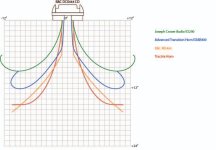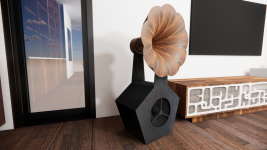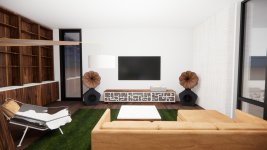I have a 4552 at hand which I could measure its internals...if interested
Edit: not complete anymore. Sorry! Forgot I did another experiment with it 🤕
Edit: not complete anymore. Sorry! Forgot I did another experiment with it 🤕
Last edited:
I am interested in an adaptor for the BMS 4550 if it is possible.. 🙂
Also, are these adaptors usable with any Gen 2 horn including the 460D?
Also, are these adaptors usable with any Gen 2 horn including the 460D?
No, only the horns that have "G2" in their designation are interchangeable and compatible with the Gen2 adapters.
The other horns are different, A460D being completely different.
Gen2 is everything here: https://at-horns.eu/gen2.html
And everything else is not Gen2.
The other horns are different, A460D being completely different.
Gen2 is everything here: https://at-horns.eu/gen2.html
And everything else is not Gen2.
I have BMS 4540nd here -(same as JBL 2407)- I'm happy to dismantle. I wonder how low they would go. The data sheet shows an interesting shelf 800-1500.
https://www.bmsspeakers.com/fileadm...d_2011-04_hf_neodymium_compression_driver.pdf
https://www.bmsspeakers.com/fileadm...d_2011-04_hf_neodymium_compression_driver.pdf
Hi Marcel!Any recommendations for another BMS driver that it would be worth making a long adapter for, in the same way as for the 4554?
I went through their catalogue and the differences between the drivers are not always quite clear to me. Which one to try next?
Impressive results! Well done <3
I think the 5530ND should be the best option as it's their latest one. It looks like a slightly updated 4552ND (lighter, cheaper, smoother?).
I have both 4554 and 5530ND and could help out with trying them out. Also a printed A520G2.
/Anton
That said, I already have a 4554 adpater for the A460D: https://www.diyaudio.com/community/...-design-the-easy-way-ath4.338806/post-7829045The other horns are different, A460D being completely different.
It hasn't been published yet, as the appeal is not as strong, IMO.
I thought the same at first (not having the 5530 at hand), but is it really smoother? Because I don't think there's a reason why to pay for just lighter.I think the 5530ND should be the best option as it's their latest one. It looks like a slightly updated 4552ND (lighter, cheaper, smoother?).
I also think that the 4550 and 4554/4555 would be pretty much the same, wouldn't they? The cost is also similar,
Anyway, this is the BMS 4554 + Gen2 (could it be even smoother?):
I have a confession to make - I fell in love with this. It sounds so right and natural....
(4554/EXT)

(4554/EXT)
Last edited:
Apparently 4538 and 4544 are much the same as 4550, although I have no first hand experience. Was about to buy 4544 at one point. And isn't 4552ND same as 4550 except neodymium? If they have similar throats one adapter would cover four drivers and might have some demand I guess. Perhaps these are already replaced with newer models like 5530NdI am interested in an adaptor for the BMS 4550 if it is possible.. 🙂
Also, are these adaptors usable with any Gen 2 horn including the 460D?
https://forum.speakerplans.com/bms-drivers-and-comps_topic38638_page2.html
4538 has a different phase plug: https://en.toutlehautparleur.com/repair-diaphragm-for-bms-4538-8-ohm.html
(Could be even better, hard to guess.)
4550: https://en.toutlehautparleur.com/repair-diaphragm-for-bms-4550-8-ohm.html
4544: https://en.toutlehautparleur.com/repair-diaphragm-for-bms-4544-8-ohm.html
4554: https://en.toutlehautparleur.com/repair-diaphragm-for-bms-4554-8-ohm.html
5530: https://en.toutlehautparleur.com/repair-diaphragm-for-bms-5530-8-ohm.html
(Could be even better, hard to guess.)
4550: https://en.toutlehautparleur.com/repair-diaphragm-for-bms-4550-8-ohm.html
4544: https://en.toutlehautparleur.com/repair-diaphragm-for-bms-4544-8-ohm.html
4554: https://en.toutlehautparleur.com/repair-diaphragm-for-bms-4554-8-ohm.html
5530: https://en.toutlehautparleur.com/repair-diaphragm-for-bms-5530-8-ohm.html
Last edited:
Did you think about giving 4554 with st260 a try? Directivity will stop earlier but LF coupling with a seperate 8-12" would be much improved (depending on possible lf extension in that combination).
Faital states "21° Conical", which should be a good match for the T520-25-STD-3.I was wondering what adaptor I should be using for HF10AK, as far as I know this driver has a 10.5deg exit angle.
+ You can always try the T520-25-EXT-1, even if just to see what you get.
I posted this as an independent thread but because I see that you all are talking about the DCX 464 here maybe this is a better spot to put it.
I've been lurking here for a long time with some moderate contributions, and have been scouring the forums trying to understand a direction for a custom speaker I'm building around the B&C DCX464. Really, it's being designed around aesthetics - I have always loved the look of big wood horns ala Oswalds Mill Audio and A for Ara. I know the two aforementioned companies build luxury items for a price point that is out of reach for almost everyone, with a sound quality that can likely be achieved for much lower; however, I'm an architect and one of my fatal flaws is that I like how things look as much as how they perform.
The design for this speaker thus started with a visual idea more than an acoustical one - I wanted a big (24" +/-) round wood horn set atop a bass cabinet down below. In looking at several options, it appeared to me the best way to achieve this was to 1. keep the crossover point relatively low (to achieve more flexibility in driver-to-driver spacing) and try to play as much of the frequency range from the horn to keep it as point-source as possible. I saw the DCX464 reviewed relatively favorably on Joseph Crowe's site, and given its broad range and low crossover possibilities, I thought that driver might be the ticket.
I use a program called "Rhino" for work, almost 8 hours a day, and have been for nearly 15 years - so there is nothing outside my capability for modeling. I am also an expert in a parametric program called "grasshopper," so I've been able to translate some of the more complex math involved in various designs into parametric models that allow for extremely fast and quick experimentation (I have built a pretty comprehensive model that allows me to iterate through tractrix horn constructs with petals). I have a 3D printer and a CNC and have been building furniture for 25 years, so there are few things outside my fabrication abilities.
Where I quickly fall apart is trying to determine what exactly the geometry of the actual horn/waveguide should be. I have read a lot of different opinions, but realistically what I'm looking for is good sound that works on a relatively wide dispersion - it doesn't have to be the same EVERYWHERE, but I'd like to avoid a full-range pin-point sweet spot if at all possible.
I've been looking at a lot of other precedents for contemporary horn drivers, including the Oblate Spheroid waveguide, Joseph Crowes ES290 horn, the Advance Transition Horn EXAR (I purchased the 3d files yesterday just to get the curves and geometry), and tractrix horns in order to try to find some commonality between all of them in the design. I have drawn all these in CAD and plotted them for comparison.
I'm also curious about the "pleats" in the X-Shape waveguide (mostly because I could fabricate and think it looks cool) - but don't really understand what it is doing acoustically. https://audiohorn.net/x-shape-horn/
Attached is the curve plot comparison, as well as a couple of early renderings of what I think the cabinet would generally look like. I was looking at the Faital Pro FR400 for the lower end. I'd be doing an active system with maybe a passive crossover for the compression driver. I'm looking for opinions - about horn design, general thoughts on the speaker design, etc. Thank you!
I've been lurking here for a long time with some moderate contributions, and have been scouring the forums trying to understand a direction for a custom speaker I'm building around the B&C DCX464. Really, it's being designed around aesthetics - I have always loved the look of big wood horns ala Oswalds Mill Audio and A for Ara. I know the two aforementioned companies build luxury items for a price point that is out of reach for almost everyone, with a sound quality that can likely be achieved for much lower; however, I'm an architect and one of my fatal flaws is that I like how things look as much as how they perform.
The design for this speaker thus started with a visual idea more than an acoustical one - I wanted a big (24" +/-) round wood horn set atop a bass cabinet down below. In looking at several options, it appeared to me the best way to achieve this was to 1. keep the crossover point relatively low (to achieve more flexibility in driver-to-driver spacing) and try to play as much of the frequency range from the horn to keep it as point-source as possible. I saw the DCX464 reviewed relatively favorably on Joseph Crowe's site, and given its broad range and low crossover possibilities, I thought that driver might be the ticket.
I use a program called "Rhino" for work, almost 8 hours a day, and have been for nearly 15 years - so there is nothing outside my capability for modeling. I am also an expert in a parametric program called "grasshopper," so I've been able to translate some of the more complex math involved in various designs into parametric models that allow for extremely fast and quick experimentation (I have built a pretty comprehensive model that allows me to iterate through tractrix horn constructs with petals). I have a 3D printer and a CNC and have been building furniture for 25 years, so there are few things outside my fabrication abilities.
Where I quickly fall apart is trying to determine what exactly the geometry of the actual horn/waveguide should be. I have read a lot of different opinions, but realistically what I'm looking for is good sound that works on a relatively wide dispersion - it doesn't have to be the same EVERYWHERE, but I'd like to avoid a full-range pin-point sweet spot if at all possible.
I've been looking at a lot of other precedents for contemporary horn drivers, including the Oblate Spheroid waveguide, Joseph Crowes ES290 horn, the Advance Transition Horn EXAR (I purchased the 3d files yesterday just to get the curves and geometry), and tractrix horns in order to try to find some commonality between all of them in the design. I have drawn all these in CAD and plotted them for comparison.
I'm also curious about the "pleats" in the X-Shape waveguide (mostly because I could fabricate and think it looks cool) - but don't really understand what it is doing acoustically. https://audiohorn.net/x-shape-horn/
Attached is the curve plot comparison, as well as a couple of early renderings of what I think the cabinet would generally look like. I was looking at the Faital Pro FR400 for the lower end. I'd be doing an active system with maybe a passive crossover for the compression driver. I'm looking for opinions - about horn design, general thoughts on the speaker design, etc. Thank you!
Attachments
I think @Olombo made some experiments with the DCX464 in an ATH horn already. Can't recall seeing any other measurements. Scaling the EXAR400 for a 1.4" throat is certainly an option (that's what @olegtern did), although I'm not sure it's the best choice here, as you shouldn't need any LF boost with the coax. My bet would be an A520G2/36-STD-1 - that's what I would try first if I had to use that driver 🙂. Midrange clarity should be exceptional. I'm still not sure about the high frequencies with a coax in general, I just remained unconvinced. Can't comment on the other options.
If you wanted something even bigger than the A520G2, just let me know, it's not a problem. And as I understand, a DXF of the profile (or even a set of coordinates) is all you need. I also know someone working with grasshopper/Rhino on an expert level and it's amazing.
If you wanted something even bigger than the A520G2, just let me know, it's not a problem. And as I understand, a DXF of the profile (or even a set of coordinates) is all you need. I also know someone working with grasshopper/Rhino on an expert level and it's amazing.
Last edited:
My experiment was still before Gen2. But yes basically I would call it very good. I am as always just searching for getting even better but.... difficult 😂
With a Gen2 horn different adapters can be tried later - that's the nice thing about it. It has been designed that way from the start. You could even swap for a small BMS driver with a long throat some day 🙂
Last edited:
@mabat I actually discovered on your site last night that you have the formulas available open-source, so I started to build a parametric model in Grasshopper to make a fully-parametric 3D model that can enable one to experiment with all the variables you described, along with construction constraints (i.e. number and thickness of petals in a horn to help understand fabrication constraints), as well as throat adapters to accommodate different drivers exit angles (which I understand is already part of the script, but this would enable a parametric throat adapter as well). When I get it done I will post some screen grabs and make it available to anyone who is interested in tinkering with it! Grasshopper and Rhino are pretty amazing programs.
I noted your reluctance on the DCX464 - any particular reason? I'm interested in that driver in that it can cover from 300Hz to the upper end with one source, and I can drive it low enough that I can deal with a more flexible center to center spacing between the bass cabinet and horn; however, I am open to other suggestions.
I also saw on Joseph Crowe's site he has a rear-chamber adapter for the SB Audience 65CDN-T that lowers the Fs from 460 to 280. https://josephcrowe.com/products/3d-cad-file-rear-cover-for-sb-audience-65cdn-t
https://www.sbaudience.com/index.php/products/compression-drivers/rosso-65cdn-t/
I know he holds this driver in high regard and it is much less expensive than the DCX, so if I could get that to play to even 400hz I could make the design work.
I noted your reluctance on the DCX464 - any particular reason? I'm interested in that driver in that it can cover from 300Hz to the upper end with one source, and I can drive it low enough that I can deal with a more flexible center to center spacing between the bass cabinet and horn; however, I am open to other suggestions.
I also saw on Joseph Crowe's site he has a rear-chamber adapter for the SB Audience 65CDN-T that lowers the Fs from 460 to 280. https://josephcrowe.com/products/3d-cad-file-rear-cover-for-sb-audience-65cdn-t
https://www.sbaudience.com/index.php/products/compression-drivers/rosso-65cdn-t/
I know he holds this driver in high regard and it is much less expensive than the DCX, so if I could get that to play to even 400hz I could make the design work.
If some 1 inch drivers operate from 600 Hz, you can find quite a few 1.4 drivers that can operate from 400 without the need for an additional crossover, eg.RCF nd950, nd940, Faital Pro HF1440 can be crossed at 400 Hz in a domestic system (as I remember, RCF uses a crossover around 450-500 Hz even in some PA applications). I am very happy with the 940 driver in 520G2 WG with the 400 Hz crossover.so if I could get that to play to even 400hz I could make the design work.
You would need to insert an acoustic numerical solver into the loop to see also the actual performance. Otherwise the formulas are pretty much useless, I can tell you this right away. Typically, what looks good also performs well, but that's still far from what could be called an optimization. What you get e.g. in the Gen2 horns, are mainly the results of such optimization.@mabat I actually discovered on your site last night that you have the formulas available open-source, so I started to build a parametric model in Grasshopper to make a fully-parametric 3D model that can enable one to experiment with all the variables you described, along with construction constraints [...]
Well, I have no first hand experience, but from what I've seen, I'm not convinced that the HF range is not quite seriously compromised. I guess that's just given by the construction of these drivers - I think this was even discussed here a few pages back. If anyone has data that would speak otherwise, please share it, I'm ready to change my mind (and would like to, in fact).I noted your reluctance on the DCX464 - any particular reason?
It can perhaps help to eliminate resonances inside the back chamber (if filled with damping), maybe it can shape the frequency response in that range a bit in a favourable way, but it can't in any way lower the usable range of the driver, as this will be still limited by the excursion, where nothing changes.I also saw on Joseph Crowe's site he has a rear-chamber adapter for the SB Audience 65CDN-T that lowers the Fs from 460 to 280.
Last edited:
- Home
- Loudspeakers
- Multi-Way
- Acoustic Horn Design – The Easy Way (Ath4)


